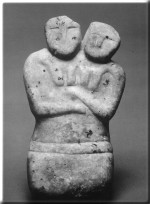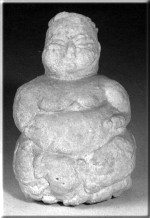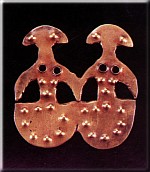|
|
|
Introduction to Anatolia
The history of Anatolia, the Turkish homeland is simply incredible. The world's oldest city was discovered, here, at Catal Hoyuk in 7500 BC. The Hittite Empire, little known in the west, rivaled that of ancient Egypt, and left behind captivating works of art.
The heartland of classical Hellenic culture is actually in Turkey, including cities such as Troy, Pergamum, Ephesus , Miletus and Halicarnassus. Most modern Turkish cities have a Roman past and all have a Byzantine one. The Seljuk Turkish Empire could boast of people like Omar Khayyam and Celaleddin Rumi, the poet, mystic and founder of the order of Whirling Dervishes. Turkey's history is astoundingly long, extending for almost 10,000 years
|
 Neolithic Age ( 8000 BC - 5000 BC )
Neolithic Age ( 8000 BC - 5000 BC )
This period reveals a new step in the history of mankind with the development of the established and settled societies and production of food. Anatolia once again gives the most comprehensive sites in the world for this age with Cayonu, Hacilar, Catalhoyuk and Koskhoyuk excavation sites.
The Cayonu settlement which is not far from the city of Diyarbakir has been unearthed by the expedition teams under the leadership of Cambel, Braidwood, Mehmet Ozdogan, Wulf Schirmen and it is dated back to 7250-6750 BC. In the middle of the settlement is a center and around it are monumental, rectangular structures and houses. The foundation of the structures is stone and above is sun-dried brick. The inhabitants of Cayonu are the first farmers of Anatolia. They raised sheep and goat, and domesticated dog. The woman figurines among the finds discovered are the earliest traces of the Mother Goddess cult.
|
|
The Prehistoric Times
Paleolithic Age ( Old Stone Age ) ( 2 Million - 8000 BC )
Paleolithic Age, also known to be the old stone age, begins somewhere between 2 million years ago and ends 10.000 years before our time. This time period marks the beginning of the existence of the ancestors of man.
The early man in the Paleolithic age did not know to farm and raise crops but lived on picking up vegetables, fruit and on hunting. In search of the new food sources and to be able to hunt animals, he moved from place to place , and gathered in small groups. His dwelling was in rocky areas, under big rocks and in caves. In areas where this condition could not be met he made easy and primitive shelters out of wood. Around 40.000 BC he started making simple stone tools for hunting and protection purposes.
Between 40.000 and 10.000 is the glacial age on earth. Not being able to move much due to the climate, the primitive man utilized the skin of the animals that he hunted by successfully carved stones. To make clothes he used pins made out of bones and saw animal skin covers for himself. During this hard time of survival , he was able to discover and to control fire and by doing so he happened to have passed an important step in his development which helped him be separated from the animals. In this same period the earliest notion of the need to believe in an other world or in a mightier power can also be traced. In the graves that were dug for the dead as simple holes he left food by the side of the deceased and this is interpreted to be his faith in afterlife.
|
|
Chalcholithic Age ( Copper Age) ( 5500-3000 BC)
In this period, in addition to stone tools copper pieces also come into sight. The need to change valuable goods (ceramics, textile) for both raw and shaped mines helped the trade develop, and this brought the exchange between peoples and the preparation of inventory listings with the beginning of communication. Symbols, hieroglyphs, writing with pictures, came into use. By the end of the 4000 BC cities emerged and the first steps of the human civilization were made.
Go to Travel page
Bronze Age ( 3000 - 1200 BC ).
The Bronze period begins around 3000 in Anatolia, around 2500 in the Aegean and Crete, around 2000 in Europe. Bronze is obtained by mixing copper and tin ( % 90 copper, % 10 tin). In this period apart from bronze tools other kinds such as copper, gold and electron, which is an alloy of natural gold and silver are also produced for using in religious ceremonies. The people in this period lived in cities surrounded with fortification walls. Houses are built in rectangular shapes on stone foundations with sundried brick walls and. Agriculture, animal husbandry, merchandise and mine production are the means of life.
Turkey Hotels
|
 .
. |

Alacahoyuk, 67 km to Yozgat city and 3 hours away from Ankara is the most advanced settlement area in Anatolia from this period. The rich graves discovered here are in shapes of regular stone rooms. The dead is put in the center of these rooms with gifts, in a posture that the knees are pulled up to the belly ( hocker position). Sacrificed and presented during the ceremony, bull heads and feet are left on top of the roofs. Goats and sheep are also sacrificed. They might have been served to the attendants at the funeral. The graves are thought to be used for many generations. Most of the gifts are composed of gold, silver, electron, bronze objects and decorative items such as diadems, necklaces, hairpins, bracelets, earrings made of precious stones like amber, rock crystal, etc. Bronze and gold weapons, sun discs, deer and bull figurines, goddess statues of religious services are invaluable works of art discovered here. For the first time in this period do we find bronze spear heads in Anatolia. They resemble very much to their counterparts in Mesopotamia and Syria which is an interesting point.
. |
|
|


